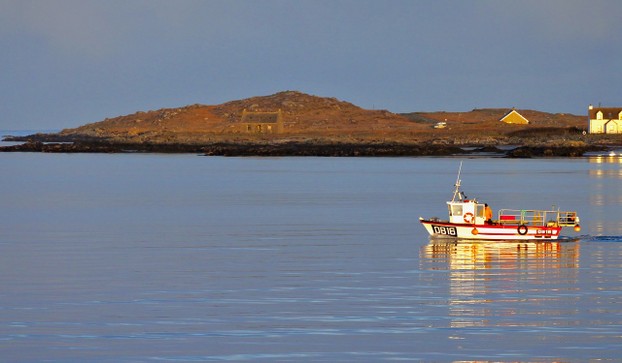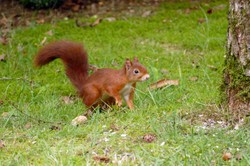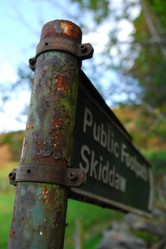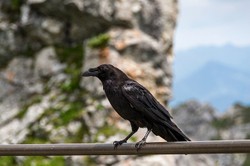For a place named in honour of the Celtic Thundergod, Taran, Taransay is very quiet, an island where for much of the year only the bleating of sheep and the booming of winds breaks the vast and awesome silence of nature. As is the case with many Hebridean islands its fifty acres were subject to depopulation, especially in the nineteenth century, when pernicious, greedy capitalists drove the island population into enforced emigration in the Highland Clearances. Isles which managed to save a remnant population necessary to maintain pastoral sheep farming were fatally deprived of the numbers of people needed to sustain a breeding population, and young people, reft of opportunities, migrated to the cities of Scotland and beyond.in 1974 the isle was abandoned and the last surviving farmer left, leaving a land where only fleeting memories, spectres of better times, flitted across desolate hills.
The island is about fifty acres and was once home to a population of seventy six people. It is composed of two rocky elevations with a low, sandy patch in the middle. Geologically, the island is composed of a bedrock of Lewisian gneiss, an old, harsh, precambrian rock devoid of minerals through eons of leaching. This meant that the islanders would have had to use a lazy bed system of crop growing, in which ridges of manure and seaweed were laid down as the basis for crop growing, mainly potatoes and barley. There is one tree on the island, though there seems to have been trees on several Hebridean isles in the Mesolithic period, when soil samples reveal hazel trees on some isles. However, soil erosion due to Atlantic weather may have made growing conditions less friendly over the millennia, so inferences on this matter are tentative.
The island had a brief place in the sun in 2000, when it became the site of a year long social experiment televised as Castaway, when for a year a community of downshifters worked to develop a self-sufficient lifestyle. Some did well, but there were tensions and one particularly difficult character created trouble. That makes good television, doesn't it? The television got good ratings, but it did nothing for the island, and after a year the castaways and film crews left, leaving the island to return to its silent slumber.
But the island changed hands, once in a card game and eventually fell into the hands of a group of crofters, farmers who tend the harsh lands of north Scotland. They, however, sold it on to a couple who had ideas for the isle. They had experience in running survival courses, and so a course on an island brought to public attention by television would be a good business opportunity, they thought.






 TheThousand Year Garden29 days ago
TheThousand Year Garden29 days ago
 Women of the Gospelson 10/11/2025
Women of the Gospelson 10/11/2025
 Religious Gardenson 08/25/2025
Religious Gardenson 08/25/2025
 Doctor of the Church: John Henry Newmanon 08/03/2025
Doctor of the Church: John Henry Newmanon 08/03/2025



Comments
The red squirrel can nest in conifers , but the grey cannot. But greys carry a disease fatal to the native red. The two should as far as possible stay apart. They do not interbreed. Efforts are being made to suppress grey numbers by contraception. The Isle of Anglesey, where my daughter lives, and where I was yesterday, is a site which has kept the greys at bay.
Thank you!
Gray and red squirrels as respective west- and east-pond natives, east- and west-pond naturalizees always fit more with what online and published sources furnish scientifically if not always anecdotally.
Unitedstatesian eastern versus western gray squirrels guard respective arboreal preferences for beech, hickory, oak and walnut versus pine trees.
What might matter most arboreally to British-Isles red squirrels?
The grey squirrel is not native to Britain. The red is native fauna over here
Thank you!
The first paragraph to the third subheading, What future is there for Taransay, advises us that "A wood would be an ideal place for red squirrels, Britain's native squirrel now largely restricted to fringe areas."
The biogeographical story on the western side of the Atlantic pond considers that (now Unitedstatesian) North America domiciled forests from the entire east coast westward such that the native red squirrel enjoyed filing from touching tree-branch to touching tree-branch all the way to the Mississippi River.
The English settlers finished off that tree-to-tree forest, got rid of the native earthworms, had red squirrels housed in the British Isles and housed their own native British-Isles earthworms and native gray squirrels there.
So Unitedstatesian biogeographies identify gray squirrels as native east- and naturalized west-side ponders and red squirrels as native west- and naturalized east-side ponders.
How might that tally with British-Isles biogeographical accounts?
You are probably right on this surmise.
Thank you!
That's a bit disappointing to latch onto something that looks like a lone-tree candidate and to learn that it only lives elsewhere in the Hebrides.
But I like your rowan tree bird-dispersed (all the way from where?) best anyway.
(Might absent middens nudge archaeologists towards no ancient settlements on Thunder-God island?)
Possibly. The hazel husks were discovered in the archaeological excavation of middens in the inner Hebrides. Taransay is Outer Hebrides and no Midden has been found
Thank you!
The second paragraph to the first subheading, Historical background, considers that "There is one tree on the island, though there seems to have been trees on several Hebridean isles in the Mesolithic period, when soil samples reveal hazel trees on some isles. However, soil erosion due to Atlantic weather may have made growing conditions less friendly over the millennia, so inferences on this matter are tentative."
Might there have been hazel trees on Thunder-God island?
Rowan trees are spread through the British Isles, naturally in rocky terrain, but in lowland areas as an ornamental.
Thank you!
A sandy peninsula apparently anchors one component island to another in the two-island Thunder-God island. Online sources bare as land cover granite-veined metamorphic rock, heathland, machair grassland and peatland. They characterize machair grassland as clustering wildflowers.
Owners Adam and Cathra Kelliher designate, on their Borve Lodge Estate site, as native species desirable for island reintroduction Scottish alder, ash and willow.
No information there or anywhere else emerges regarding the location and the species of the lone thunder-god island tree!
So your rowan suggestion, particularly with your suggested seed-dispersing birds, sounds logically-est likely-est!
(Would the nearest land to Thunder-God island host rowan trees?)